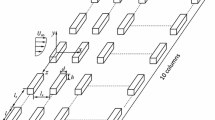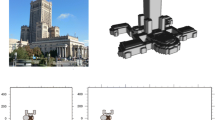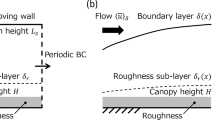Abstract
A study of the neutrally-stratified flow within and over an array of three-dimensional buildings (cubes) was undertaken using simple Reynolds-averaged Navier—Stokes (RANS) flow models. These models consist of a general solution of the ensemble-averaged, steady-state, three-dimensional Navier—Stokes equations, where the k-ε turbulence model (k is turbulence kinetic energy and ε is viscous dissipation rate) has been used to close the system of equations. Two turbulence closure models were tested, namely, the standard and Kato—Launder k-ε models. The latter model is a modified k-ε model designed specifically to overcome the stagnation point anomaly in flows past a bluff body where the standard k-ε model overpredicts the production of turbulence kinetic energy near the stagnation point. Results of a detailed comparison between a wind-tunnel experiment and the RANS flow model predictions are presented. More specifically, vertical profiles of the predicted mean streamwise velocity, mean vertical velocity, and turbulence kinetic energy at a number of streamwise locations that extend from the impingement zone upstream of the array, through the array interior, to the exit region downstream of the array are presented and compared to those measured in the wind-tunnel experiment. Generally, the numerical predictions show good agreement for the mean flow velocities. The turbulence kinetic energy was underestimated by the two different closure models. After validation, the results of the high-resolution RANS flow model predictions were used to diagnose the dispersive stress, within and above the building array. The importance of dispersive stresses, which arise from point-to-point variations in the mean flow field, relative to the spatially-averaged Reynolds stresses are assessed for the building array.
Similar content being viewed by others
References
Baik, J. and Kim, J.: 1999, ‘A Numerical Study of Flow and Pollutant Dispersion Characteristics in Urban Street Canyons’, J. Appl. Meteorol. 38, 1576–1589.
Böhm, M., Finnigan, J. J., and Raupach, M. R.: 2000, ‘Dispersive Fluxes and Canopy Flows: Just How Important Are They?’, in Proceedings of the 24th Conference on Agricultural and Forest Meteorology, American Meteorological Society, Davis, CA, pp. 106–107.
Brown, M. J., Lawson, R. E., DeCroix, D. S., and Lee, R. L.: 1999, Mean Flow and Turbulence Measurements around a 2-D Array of Buildings in a Wind Tunnel, Report LA-UR-99-5395, Los Alamos National Laboratory, Los Alamos, NM, 7 pp.
Brown, M. J., Lawson, R. E., DeCroix, D. S., and Lee, R. L.: 2001, Comparison of Centreline Velocity Measurements Obtained around 2D and 3D Building Arrays in a Wind Tunnel, Report LA-UR-01-4138, Los Alamos National Laboratory, Los Alamos, NM, 7 pp.
Cheng, H. and Castro, I.: 2002, ‘Near Wall Flow over Urban-Like Roughness’, Boundary-Layer Meteorol. 104, 229–259.
Cheng, Y., Lien, F. S., Yee, E., and Sinclair, R.: 2003, ‘A Comparison of Large Eddy Simulations with a Standard k-∈ Reynolds-Averaged Navier-Stokes Model for the Prediction of Fully-Developed Turbulent Flow over a Matrix of Cubes’, J. Wind Eng. Indust. Aero. 91, 1301–1328.
Dawson, P., Stock, D. E., and Lamb, B.: 1991, ‘The Numerical Simulation of Airflow and Dispersion in Three-Dimensional Recirculation Zones’, J. Appl. Meteorol. 30, 1005–1024.
DeCroix, D. S.: 2002, ‘Large-Eddy Simulation of Urban Dispersion during the URBAN2000 Field Program IOP-10’, in Fourth Symposium on the Urban Environment, American Meteorological Society, Norfolk, VA, May 20-24, pp. J30–J31.
Durbin, P. A.: 1995, ‘Separated Flow Computations with the k-∈-υ 2 Model’, AIAA J. 33, 659–664.
Ferziger, J. H. and Perić, M.: 1996, Computational Methods for Fluid Dynamics, Springer-Verlag, Berlin, 356 pp.
Gatski, T. B. and Speziale, C. G.: 1993, ‘On Explicit Algebraic Stress Models for Complex Turbulent Flows’, J. Fluid Mech. 254, 59–78.
Globus, A., Levit, C., and Lasinski, T.: 1991, A Tool for Visualizing the Topology of Three-Dimensional Vector Fields, Technical Report RNR-91-017, NASA Ames Research Center, Moffett Field, CA, 8 pp.
Hanna, S. R., Tehranian, S., Carissimo, B., Macdonald, R. W., and Lohner, R.: 2002, ‘Comparisons of Model Simulations with Observations of Mean Flow and Turbulence within Simple Obstacle Arrays’, Atmos. Environ. 36, 5067–5079.
Hosker, R. P.: 1985, ‘Flow Around Isolated Structures and Building Clusters: A Review’, ASHRAE Trans. 91, 1671–1692.
Hunt, J. C. R., Abell, C. J., Peterka, J. A., and Woo, H.: 1978, ‘Kinematical Studies of the Flows Around Free or Surface-Mounted Obstacles; Applying Topology to Flow Visualization’, J. Fluid Mech. 86, 179–200.
Hunter, L. J., Johnson, G. T., and Watson, I. D.: 1992, ‘An Investigation of Three-Dimensional Characteristics of Flow Regimes within the Urban Canyon’, Atmos. Environ. 26B, 425–432.
Jones, W. P. and Launder, B. E.: 1972, ‘The Prediction of Laminarizarion with a Two-Equation Model of Turbulence’, Int. J. Heat Mass Transfer 15, 301–314.
Kato, M. and Launder, B. E.: 1993, ‘The Modelling of Turbulent Flow around Stationary and Vibrating Square Cylinders’, in Proceedings of the 9th Symposium on Turbulent Shear Flows, Kyoto, Japan.
Launder, B. E., Reece, G. J., and Rodi, W.: 1975, ‘Progress in the Development of a Reynolds Stress Turbulence Closure’, J. Fluid Mech. 68, 537–566.
Leonard, B. P.: 1979, ‘A Stable and Accurate Convective Modelling Procedure Based on Quadratic Upstream Interpolation’, Comp. Meth. Appl. Mech. Eng. 19, 59–98.
Lien, F. S. and Leschziner, M. A.: 1994, ‘A General Non-Orthogonal Finite-Volume Algorithm for Turbulent Flow at all Speeds Incorporating Second-Moment Closure, Part 1: Numerical Implementation’, Comp. Meth. Appl. Mech. Eng. 114, 123–148.
Lien, F. S., Yee, E., and Cheng, Y.: 2004, ‘Simulation of Mean Flow and Turbulence over a 2-D Building Array Using High-Resolution CFD and a Distributed Drag Force Approach, J. Wind Eng. Ind. Aero. 92, 117–158.
Liu, C. H. and Barth, M. C.: 2002, ‘Large-Eddy Simulation of Flow and Scalar Transport in a Modelled Street Canyon’, J. Appl. Meteorol. 41, 660–673.
Martinuzzi, R. and Tropea, C.: 1993, ‘The Flow Around a Surface-Mounted Prismatic Obstacle Placed in a Fully Developed Channel Flow’, J. Fluids Eng. 115, 85–92.
Patankar, S. V.: 1980, Numerical Heat Transfer and Fluid Flow, Hemisphere Publishing Corporation, New York, 197 pp.
Patel, V. C., Rodi, W., and Scheuerer, G.: 1985, ‘Turbulence Models for Near-Wall and Low-Reynolds Number Flows: A Review’, AIAA J. 23, 1308–1319.
Paterson, D. A. and Apelt, C. J.: 1986, ‘Computation of Wind Flows over Three-Dimensional Buildings’, J. Wind Eng. Indust. Aero. 24, 193–213.
Paterson, D. A. and Apelt, C. J.: 1989, ‘Simulation of Wind Flow around Three-Dimensional Buildings’, Build. Environ. 24, 39–50.
Raupach, M. R., Coppin, P. A., and Legg, B. J.: 1986, ‘Experiments on Scalar Dispersion within a Model Plant Canopy, Part 1: The Turbulence Structure’, Boundary-Layer Meteorol. 35, 21–52.
Rhie, C. M. and Chow, W. L.: 1983, ‘Numerical Study of the Turbulent Flow Past an Airfoil with Trailing Edge Separation’, AIAA J. 21, 1525–1532.
Smith, W. S. and Brown, M. J.: 2002, ‘A CFD-Generated Wind Field Library Feasibility Study: Maximum Wind Direction Interval’, in Fourth Symposium on the Urban Environment, American Meteorological Society, Norfolk, VA, pp. 196–197.
Synder, W. H.: 1981, Guidelines for Fluid Modelling of Atmospheric Dispersion, Report Number EPA-600/8-81-009, Environmental Protection Agency, Research Triangle Park, NC, 200 pp.
Tobak, M. and Peake, D. J.: 1982, ‘Topology of 3-D Separated Flows’, Annu. Rev. Fluid Mech. 14, 61–85.
Townsend, A. A.: 1980, The Structure of Turbulent Shear Flows, Cambridge University Press, Cambridge, U.K., 444 pp.
Versteeg, H. K. and Malalasekera, W.: 1995, An Introduction to Computational Fluid Dynamics, Addison Wesley Longman Ltd, Essex, U.K., 257 pp.
Walton, A. and Cheng, A. Y. S.: 2002, ‘Large-Eddy Simulation of Pollution Dispersion in an Urban Street Canyon-Part II: Idealized Canyon Simulation’, Atmos. Environ. 36, 3615–3627.
Yamada, T.: 2002, ‘A Multi-Scale Mesoscale Atmospheric Model for Simulation of Airflow around Buildings in Complex Terrain’, in Fourth Symposium on the Urban Environment, American Meteorological Society, Norfolk, VA, pp. J36–J37.
Zhang, Y. Q., Huber, A. H., Arya, S. P. S., and Synder, W. H.: 1993, ‘Numerical Simulation to Determine the Effects of Incident Wind Shear and Turbulence Level on the Flow around a Building’, J. Wind Eng. Indust. Aero. 46 & 47, 129–134.
Author information
Authors and Affiliations
Rights and permissions
About this article
Cite this article
Lien, FS., Yee, E. Numerical Modelling of the Turbulent Flow Developing Within and Over a 3-D Building Array, Part I: A High-Resolution Reynolds-Averaged Navier—Stokes Approach. Boundary-Layer Meteorology 112, 427–466 (2004). https://doi.org/10.1023/B:BOUN.0000030654.15263.35
Issue Date:
DOI: https://doi.org/10.1023/B:BOUN.0000030654.15263.35




